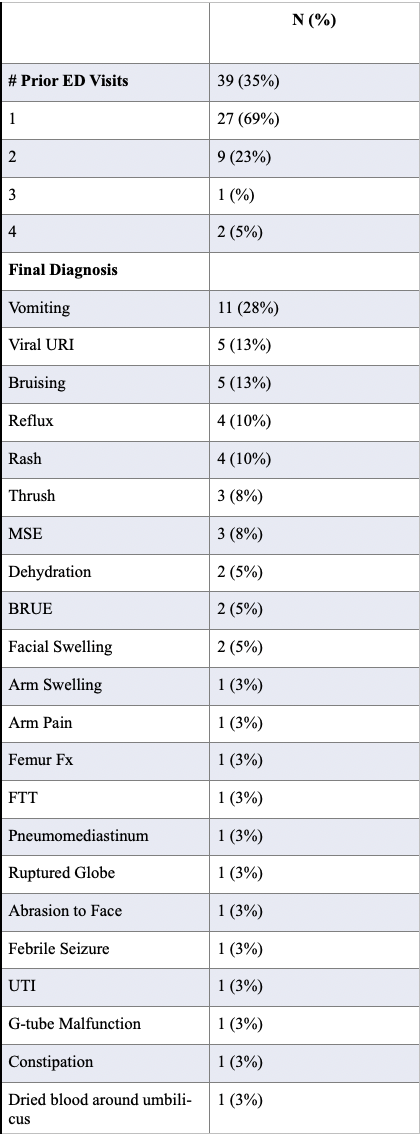Child Abuse & Neglect
Category: Abstract Submission
Child Abuse & Neglect II
230 - Child abuse screening in the pediatric emergency department
Monday, April 25, 2022
3:30 PM - 6:00 PM US MT
Poster Number: 230
Publication Number: 230.402
Publication Number: 230.402
Santhi P. Reddi, Riley Hospital for Children at Indiana University Health, Indianapolis, IN, United States; Jessica Kanis, IU Health, Indianapolis, IN, United States; Heather Kelker, Riley Hospital for Children at Indiana University Health, Indianapolis, IN, United States

Santhi P. Reddi, MD
Pediatric Emergency Medicine Fellow
Riley Hospital for Children at Indiana University Health
Indianapolis, Indiana, United States
Presenting Author(s)
Background: More than four children die every day of child maltreatment ; half of which are less than one year of age. More deaths occur with abusive head trauma (AHT) than other types of abuse.
Many children who are injured or die due to child abuse have been previously evaluated by a physician for injuries likely caused by abuse but not identified as such at the time. Additionally, there is minimal literature describing the risk associated with prior Emergency Department visits for non-injury complaints.
Objective: To determine the frequency of prior ED visits for all complaints prior to the diagnosis of AHT and to evaluate for any trends in ED visits that may indicate future AHT.
Design/Methods: Eligible patients were identified by the Riley Child Protection Team’s existing database of patients diagnosed with abusive head trauma within the past 5 years. For eligible patients, retrospective chart data collection included the following: age, sex, ethnicity, race, chief complaint of all ED visits, diagnostic studies performed, results, and interventions. Charts were also abstracted to look for prior consults to CPT and social work. This information was extracted from all prior ED visits in our IU Health system and outside ED’s identified through IHIE.
Results: During the study period, 113 patients less than 2 years old are identified as being diagnosed with AHT from 2015-2019. Of these patients, 39 (34.5%) had had a prior ED visit. 27 (69.2%) had one prior ED visit, 9 (23.1%) had two, 1 (2.6%) had three, 1 (2.6%) had four, and 1 (2.6%) had more than five. 11 patients were noted to have previous trauma or injury (9.7%) and 10 patients had had previous ED visits related to trauma. SW had previously been consulted in 10 patients (8.8%) and CPT had previously been consulted in 7 patients (6.2%). Conclusion(s): Our data illustrates that a majority of patients who were diagnosed with AHT were not previously seen in the ED prior. Of those who were, vomiting was the most common chief complaint with three patients being seen more than once for vomiting before presenting with AHT. Future studies would benefit from assessing infants who present to the ER with the chief complaint of vomiting and evaluating work up that is done at that time, specifically head imaging. Future studies will also benefit from exploring if the number of previous ED visits impacts work-up done at future visits.
Santhi Reddi CVSanthi Reddi - CV .pdf
Table 2. Number of Prior ED visits and Final Diagnosis
Many children who are injured or die due to child abuse have been previously evaluated by a physician for injuries likely caused by abuse but not identified as such at the time. Additionally, there is minimal literature describing the risk associated with prior Emergency Department visits for non-injury complaints.
Objective: To determine the frequency of prior ED visits for all complaints prior to the diagnosis of AHT and to evaluate for any trends in ED visits that may indicate future AHT.
Design/Methods: Eligible patients were identified by the Riley Child Protection Team’s existing database of patients diagnosed with abusive head trauma within the past 5 years. For eligible patients, retrospective chart data collection included the following: age, sex, ethnicity, race, chief complaint of all ED visits, diagnostic studies performed, results, and interventions. Charts were also abstracted to look for prior consults to CPT and social work. This information was extracted from all prior ED visits in our IU Health system and outside ED’s identified through IHIE.
Results: During the study period, 113 patients less than 2 years old are identified as being diagnosed with AHT from 2015-2019. Of these patients, 39 (34.5%) had had a prior ED visit. 27 (69.2%) had one prior ED visit, 9 (23.1%) had two, 1 (2.6%) had three, 1 (2.6%) had four, and 1 (2.6%) had more than five. 11 patients were noted to have previous trauma or injury (9.7%) and 10 patients had had previous ED visits related to trauma. SW had previously been consulted in 10 patients (8.8%) and CPT had previously been consulted in 7 patients (6.2%). Conclusion(s): Our data illustrates that a majority of patients who were diagnosed with AHT were not previously seen in the ED prior. Of those who were, vomiting was the most common chief complaint with three patients being seen more than once for vomiting before presenting with AHT. Future studies would benefit from assessing infants who present to the ER with the chief complaint of vomiting and evaluating work up that is done at that time, specifically head imaging. Future studies will also benefit from exploring if the number of previous ED visits impacts work-up done at future visits.
Santhi Reddi CVSanthi Reddi - CV .pdf
Table 2. Number of Prior ED visits and Final Diagnosis

